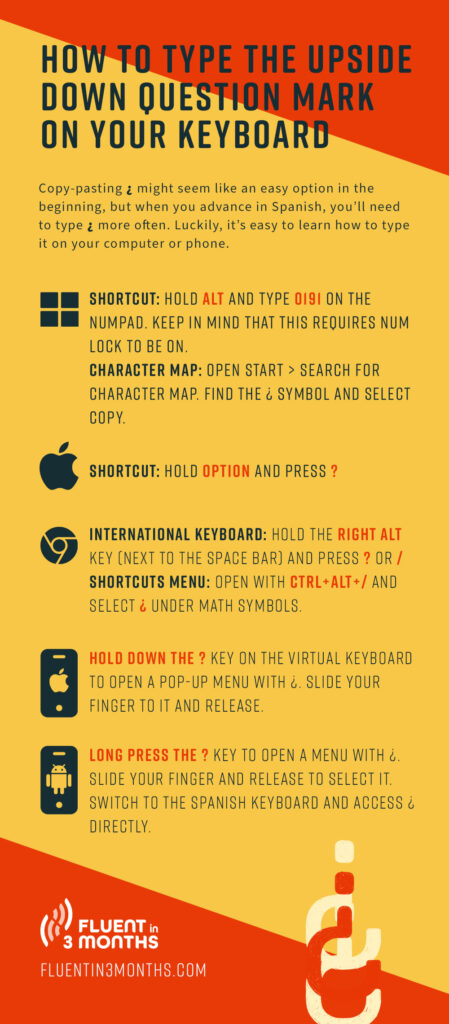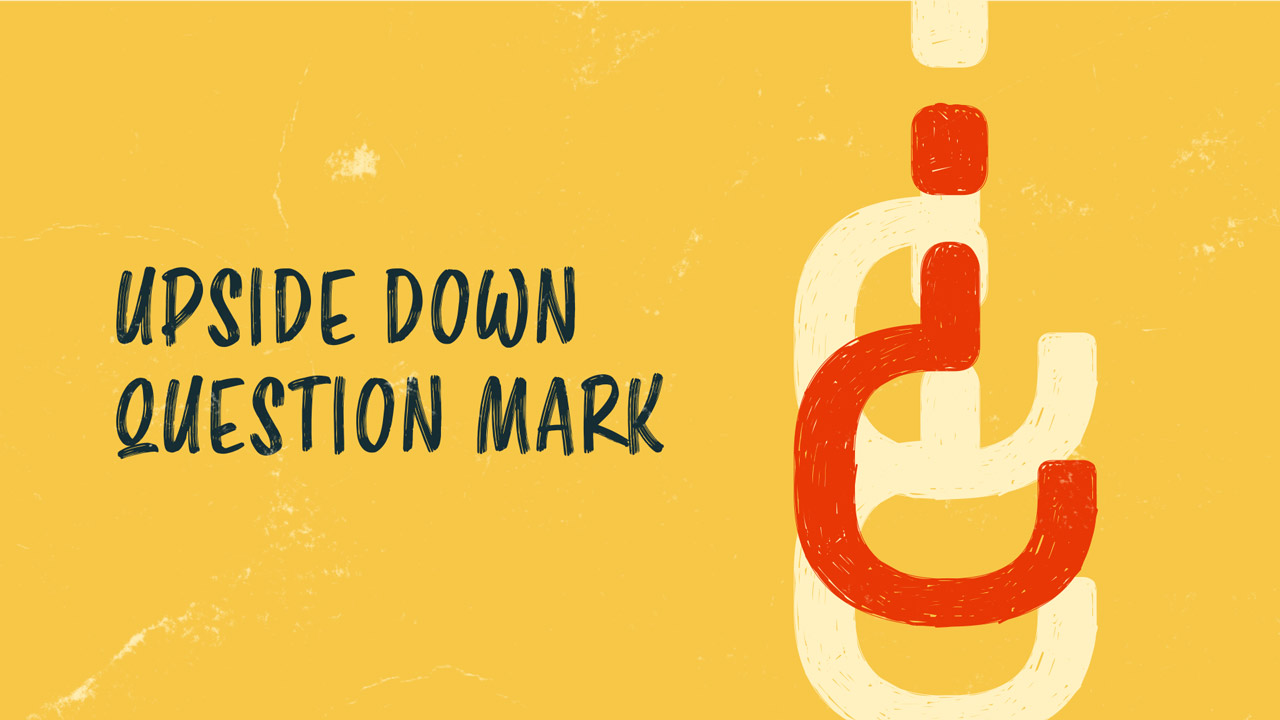Upside Down Question Mark: A Complete Guide to Using it in Spanish
The upside down question mark, ¿ may catch you off-guard when you start learning Spanish.
Why does it appear in the beginning of sentences? And how come it has this ‘inverted’ shape? Also known as the inverted question mark, the upside down question mark is not all that mysterious. It’s been a part of the Spanish language for centuries, and it serves one simple purpose: letting readers know that the upcoming sentence is a question.
While it may seem like a trivial detail, upside down question marks are mandatory to use in written Spanish. Learn why how to use them and how to type them on your computer, and take your written Spanish to the next level!.
Table of contents
- What Is the Upside Down Question Mark?
- Why Does Spanish Use the Upside Down Question Mark?
- How and When to Use the Upside Down Question Mark?
- How to Type the Upside Down Question Mark on Your Keyboard?
- Example Uses the Upside Down Question Mark
- Other Sentences with the Upside Down Question Mark
- ¿What Do You Think About the Upside Down Question Mark?
What Is the Upside Down Question Mark?
Let’s start with the basics. The upside down question mark, ¿, is the flipped version of the regular question mark, “?.” Unlike the regular question mark we’re used to, ¿ appears at the beginning of interrogative sentences or clauses in Spanish. You can think of the pair as two bookends enclosing a question.
In other words, in English, we only use “?” at the end of the sentence. Spanish uses both ¿ and “?.” Take a look at this common question, “how old are you,” in English and Spanish:
- *English: “How old are you?”
- *Spanish: ¿Cuántos años tienes?
Remember: in Spanish, the ¿ goes right before the interrogative clause, the part of the sentence indicating the question. Here are some examples:
- Tú lo viste, ¿verdad? “You saw it, right?” (¿ comes before verdad, (“right”) as this is the question clause.)
- Mañana hay clase, ¿pero igual vas a ir a la fiesta? “There’s school tomorrow, but are you still going to the party?” (¿ comes before pero igual vas a ir a la fiesta (“but are you still going to the party”), as this is the question clause.)
Spanish isn’t the only language that uses the upside down question mark. Although less common, Galician, Asturian, and Waray also have this feature. So if you’re looking to learn any of these languages in the future, you’ll want to befriend the ¿ as well.
Why Does Spanish Use the Upside Down Question Mark?
The Real Academia Española, (“Royal Spanish Academy”) recommended using inverted question marks in the 18th century. Besides the upside down question mark, the Academy also recommended inverted exclamation points, ¡. Both the inverted question mark and the exclamation mark let readers know what type of sentence they’re reading in advance. In addition to this, they help prevent ambiguity. Without the inverted and the regular question mark, it’s difficult to see which sentence is a question and which one is not in Spanish.
Today, using ¿ and “?,” as well as ¡ and “!” are standard in Spanish-speaking countries, although they have different expressions. No matter if you’re saying ¡qué lata! (“how boring!”) in Chile or ¿qué bolero? (“what’s up?”) in Cuba, you’ll use two punctuations: one in the beginning and one at the end.
How and When to Use the Upside Down Question Mark?
The upside down question mark always goes at the very beginning of a question or interrogative clause. Keep in mind that there might be more than one clause in the same sentence, but there will be only one that’s actually the question clause.
Here is a sentence with only one clause:
- ¿Vas a comprar un coche nuevo? “Are you going to buy a new car?”
And here is one with three clauses, with the question clause in the middle:
- Jimena me preguntó ¿qué haría yo en esa situación? y no supe qué decir. “Jimena asked me,” What would I do in that situation?” and I didn’t know what to say.”
Note that indirect questions that are reported or embedded within statements do not take the upside down mark:
- Julia me preguntó si yo quería ir al cine. “Julia asked me if I wanted to go to the movies.”
- Me pregunto dónde está. “I’m wondering where he/she/it is.”
Spanish may sometimes have long sentences. If the ¿ provides clarity for the reader, feel free to use it even in reported questions:
- Quiero saber ¿cuánto tiempo pasará hasta que pueda ver los resultados del examen? porque necesito hacer planes. “I want to know how long it will be until I can see the exam results? Because I need to make plans.”
¿ is not a standalone symbol. It needs to be paired with a closing “?” at the end of the question or sentence. Both are used in any question clause, even when there are multiple within the speech. Here is an example:
¿Quieres ir al banco? ¿O prefieres que vaya yo? “Do you want to go to the bank? Or do you prefer that I go?”
How to Type the Upside Down Question Mark on Your Keyboard?
Copy-pasting ¿ might seem like an easy option in the beginning, but when you advance in Spanish, you’ll need to type ¿ more often. Luckily, it’s easy to learn how to type it on your computer or phone.
Typing the Upside Down Question Mark on Windows
Shortcut: Hold Alt and type 0191 on the numpad. Keep in mind that this requires Num Lock to be on.
Character Map: Open Start > search for Character Map. Find the ¿ symbol and select Copy.
Typing the Upside Down Question Mark on Mac
Shortcut: Hold Option and press ?
Typing the Upside Down Question Mark on Chromebook
International keyboard: Hold the right Alt key (next to the space bar) and press ? or /
Shortcuts menu: Open with Ctrl+Alt+/ and select ¿ under Math Symbols.
Typing the Upside Down Question Mark on iPhone and iPad
Hold down the ? key on the virtual keyboard to open a pop-up menu with ¿. Slide your finger to it and release.
Typing the Upside Down Question Mark on Android
Long press the ? key to open a menu with ¿. Slide your finger and release to select it.
Switch to the Spanish keyboard and access ¿ directly.

Example Uses the Upside Down Question Mark
In Spanish, intonations define whether a sentence is a question or not. When you’re reading Spanish out loud, the upside down question mark will help you decide how you should read the sentences.
Let’s illustrate this with an example — vas a venir conmigo means “you will come with me.” There’s no upside down question mark in sight, so this is a normal sentence, not a question. When we add question marks, ¿vas a venir conmigo?, the meaning of the sentence changes to “will you come with me?”
Here are some examples, with audio recordings to guide you on Spanish intonations.
| English | Spanish | Audio |
|---|---|---|
| “Will you come with me?” | ¿Vas a venir conmigo? | |
| “You will come with me.” | Vas a venir conmigo | |
| “Can you help me?” | ¿Puedes ayudarme? | |
| “You can help me.” | Puedes ayudarme. | |
| “Are you ready to leave?” | ¿Estás listo para salir? | |
| “You are ready to leave.” | Estás listo para salir. | |
| “Does she eat pasta?” | ¿Ella come pasta? | |
| “She eats pasta.” | Ella come pasta. | |
| “Does he want to come?” | ¿Él quiere venir? | |
| “He wants to come.” | Él quiere venir. |
Other Sentences with the Upside Down Question Mark
No matter how simple or difficult, Spanish questions all have upside down question marks. You will see it in common questions like *¿qué hora es? (“what time is it?”), as well as more complex questions, such as ¿¡qué has hecho!? (“what have you done?!”). The latter also uses an exclamation mark to express surprise.
There’s only one catch — even when there is more than one clause in the sentence, only the question clause gets the ¿ and “?” Let’s take a look at some example sentences:
| English | Spanish | Audio |
|---|---|---|
| “What do you want to eat?” | ¿Qué quieres comer? | |
| “Can you tell me how to get to the post office?” | ¿Puedes decirme cómo llegar al correo? | |
| “Do you like coffee?” | ¿Te gusta el café? | |
| “Are you crazy?” | ¿¡Estás loco!? | |
| “Is all this for me?!” | ¿¡Todo esto es para mí!? | |
| “When you get home, can you call me?” | Cuando llegues a casa, ¿puedes llamarme? | |
| “If you go to the supermarket, could you buy milk?” | Si vas al supermercado, ¿podrías comprar leche? | |
| “Paula, did you get my message?” | Paula, ¿recibiste mi mensaje? |
¿What Do You Think About the Upside Down Question Mark?
At first glance, the upside down question mark may seem like a random punctuation, but over time, you’ll get used to it. You’ll see it everywhere, even in common Spanish phrases like “how are you” (¿cómo estás?) or “where are you from” (¿de dónde eres?). The same goes for other languages that use the upside down question mark — it’s all a matter of practice!



Social